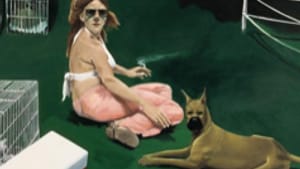Stay in the Loop
BSR publishes on a weekly schedule, with an email newsletter every Wednesday and Thursday morning. There’s no paywall, and subscribing is always free.
A story-teller, maybe. But an artist?
Eric Fischl's "Dive Deep' at Pennsylvania Academy (1st review)

Back in New York in the '80s, Eric Fischl was a really hot ticket— a darling of Mary Boone, whose gallery was an even hotter ticket. The art world, waking up to the idea that artists might actually still want to paint the human figure, went a little dizzy over Fischl's realism slathered with oils onto canvas.
I lived in New York then, so I attended the shows, read the reviews and discussed the work— and the buzz— with friends. I wasn't particularly impressed, as I recall"“ envious, maybe"“ but I didn't find all that much going on beyond the juicy surfaces.
Suburban white people in various states of undress and boredom may possess a certain downbeat chic, but the subject is such an easy target. And while there's no disputing Fischl's facility with brush and paint is impressive, facility can get in the way of significance.
Has Fischl grown or matured since then? "Dive Deep: Eric Fischl and the Process of Painting," at the Philadelphia Academy, provides a good opportunity to find out.
His approach hasn't changed, it appears: He still relies— too heavily— on photographs for his figures and compositions. His work often reflects an awkward misreading of scale and gesture; even if intentional, it's too self-serious to carry it off. In his early Woman Surrounded by Dogs (1979-80), the mismatches— perspective in the cages and cooler, the fit of the boxer's head, the woman's hovering arm— unintentionally project an uncomfortable comedic effect.
Homage to Caravaggio
Fischl's later work in the show includes several beach scenes and some interiors, all of them colorful and inviting, in Fischl's signature lush technique. Rich deep colors and dramatic lighting worthy of Caravaggio abound in photos and a painting from the Krefeld Project (2002), an installation in a museum in Germany (formerly a private home designed by Mies van der Rohe) where Fischl brought models to "live" for three days.
The painting, called Scene #4, puts a blonde woman in a red wrap at the center, surrounded by chic mid-century furnishings, and hints at a narrative with her glum expression and the obscured reflection of a man in a mirror on the back wall. It's beautiful, but so narrative that you need more: This painting is part of a novel, not a short story on its own. Even in conjunction with the other paintings in the series (which aren't on view here), the story isn't really told; and Fischl's style is so blatantly novelistic that the viewer can't invent what isn't there.
In a video at the Pennsylvania Academy exhibit, Fischl speaks with Academy students, charging them to take up the challenge of reconnecting art with audience. His implication is that the solution lies in painting, in realism and the human figure.
Rebellion or slavishness?
Fischl— who attended art school in the 1970s, when abstraction ruled— speaks of rebellion as a birthright, saying that he took up the charge of saying "yes" to figure and narrative painting when the world was saying "no." But his painting technique"“ lush, drippy, impulsive"“ seems at times all too slavishly obedient to those abstract expressionist masters.
Fischl's use of photographs, always a staple for illustrators, allows him to flaunt his technique but fails to guarantee deeper meaning, and too often his compositions exude a jigsaw puzzle quality. In a beach scene from the 2006 series, "Late Paradise," the figures in a complex arrangement of sun-washed bodies are suddenly more integrated, the composition less forced. It's a result, we learn, of Fischl's introduction to Photoshop.
The exhibit includes clusters of the photographs Fischl uses to produce his work. Many of them are interesting on their own, and they bring to mind photo work with more of a point— for instance, Jeff Wall's probing, psychological cibachromes or David Hockney's quirky Polaroid assemblages. As a result, the photos raise finicky questions about why they really need to be transformed into painting at all. Painting is enormously important; but to connect on a deep level, it must do more than simply look good.♦
To read another review by Anne R. Fabbri, click here.
I lived in New York then, so I attended the shows, read the reviews and discussed the work— and the buzz— with friends. I wasn't particularly impressed, as I recall"“ envious, maybe"“ but I didn't find all that much going on beyond the juicy surfaces.
Suburban white people in various states of undress and boredom may possess a certain downbeat chic, but the subject is such an easy target. And while there's no disputing Fischl's facility with brush and paint is impressive, facility can get in the way of significance.
Has Fischl grown or matured since then? "Dive Deep: Eric Fischl and the Process of Painting," at the Philadelphia Academy, provides a good opportunity to find out.
His approach hasn't changed, it appears: He still relies— too heavily— on photographs for his figures and compositions. His work often reflects an awkward misreading of scale and gesture; even if intentional, it's too self-serious to carry it off. In his early Woman Surrounded by Dogs (1979-80), the mismatches— perspective in the cages and cooler, the fit of the boxer's head, the woman's hovering arm— unintentionally project an uncomfortable comedic effect.
Homage to Caravaggio
Fischl's later work in the show includes several beach scenes and some interiors, all of them colorful and inviting, in Fischl's signature lush technique. Rich deep colors and dramatic lighting worthy of Caravaggio abound in photos and a painting from the Krefeld Project (2002), an installation in a museum in Germany (formerly a private home designed by Mies van der Rohe) where Fischl brought models to "live" for three days.
The painting, called Scene #4, puts a blonde woman in a red wrap at the center, surrounded by chic mid-century furnishings, and hints at a narrative with her glum expression and the obscured reflection of a man in a mirror on the back wall. It's beautiful, but so narrative that you need more: This painting is part of a novel, not a short story on its own. Even in conjunction with the other paintings in the series (which aren't on view here), the story isn't really told; and Fischl's style is so blatantly novelistic that the viewer can't invent what isn't there.
In a video at the Pennsylvania Academy exhibit, Fischl speaks with Academy students, charging them to take up the challenge of reconnecting art with audience. His implication is that the solution lies in painting, in realism and the human figure.
Rebellion or slavishness?
Fischl— who attended art school in the 1970s, when abstraction ruled— speaks of rebellion as a birthright, saying that he took up the charge of saying "yes" to figure and narrative painting when the world was saying "no." But his painting technique"“ lush, drippy, impulsive"“ seems at times all too slavishly obedient to those abstract expressionist masters.
Fischl's use of photographs, always a staple for illustrators, allows him to flaunt his technique but fails to guarantee deeper meaning, and too often his compositions exude a jigsaw puzzle quality. In a beach scene from the 2006 series, "Late Paradise," the figures in a complex arrangement of sun-washed bodies are suddenly more integrated, the composition less forced. It's a result, we learn, of Fischl's introduction to Photoshop.
The exhibit includes clusters of the photographs Fischl uses to produce his work. Many of them are interesting on their own, and they bring to mind photo work with more of a point— for instance, Jeff Wall's probing, psychological cibachromes or David Hockney's quirky Polaroid assemblages. As a result, the photos raise finicky questions about why they really need to be transformed into painting at all. Painting is enormously important; but to connect on a deep level, it must do more than simply look good.♦
To read another review by Anne R. Fabbri, click here.
What, When, Where
“Dive Deep: Eric Fischl and the Process of Painting.†Through September 30, 2012 at Pennsylvania Academy of the Fine Arts, Brooks Gallery, Hamilton Bldg., 128 N. Broad St. (at Cherry). (215) 972-7600 or www.pafa.org/fischl.
Sign up for our newsletter
All of the week's new articles, all in one place. Sign up for the free weekly BSR newsletters, and don't miss a conversation.

 Marilyn MacGregor
Marilyn MacGregor